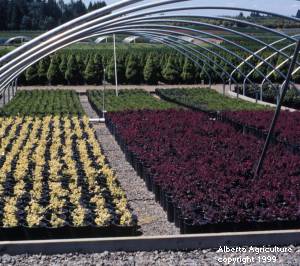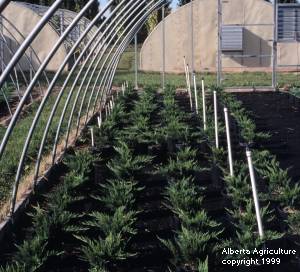| | In Alberta, container-growing of nursery stock is a smaller part of the industry. Many nurseries will pot harvested bare root trees into containers for sale or buy in container-grown stock to add to the inventory for sale. Experienced growers may produce their own container stock. As in field production, liners may be purchased and grown on in containers or, if the nursery has its own propagation facilities, they may produce their own. The following advantages and disadvantages must be considered.
.
Gold Nugget Barbarry

Hoop houses with gravel base for
container plant production. | 
Container production on landscape |
|
.
Advantages
- The grower has a higher level of management of media, fertility, and irrigation regimes.
- The product can be sold and transplanted at any time during the growing season.
- Container plants generally have accelerated growth and therefore a quicker turnover in the nursery.
- Container production requires less land.
Disadvantages
- Containers involve higher production costs.
- There is usually a lower return on investment ratio.
- Intensive management is required.
- It is more labour intensive.
- Plant growth can be limited by pot size.
- Plants require overwintering facilities.
- Typically only shrub species are grown in containers.
- Pots may turn over in windy situations.
Media
Nursery container media must have good physical characteristics such as sufficient porosity, water holding capacity, adequate pH (between 5.5 and 6.5), and cation exchange capacity (CEC). The media should also be light weight which is an important consideration if shipping is involved. The ideal medium for container growing is inexpensive and readily available. A medium can be developed to accommodate the availability of the various components, but a typical one could contain the following: 10% nursery compost, 10% sand, 20% peat, and 60% sawdust.
Fertility
Container media generally lacks any inherent nutrients; therefore, all nutrients must be supplemented. Nutrients are supplied to containers with slow release fertilizer which has been mixed into the media prior to planting or with soluble fertilizer applied through an injector system. Slow release fertilizer is available with various release periods and has become the preferred method. Care must be taken to ensure most nutrients are released in the early season to avoid excess late season growth which would delay hardening off and the onset of dormancy. Micronutrient mixes should be added to the media initially to supplement the slow release program.
Overwintering
The least cold tolerant portion of a plant is the root system and in container production, the roots do not have the natural insulation of the surrounding soil. In Southern Alberta where the insulation of good snow cover is not reliable, overwintering requires a cover of some type for the containers. In central and northern Alberta, snow cover is more dependable, but should not be relied on solely. To overwinter containers, pots should be consolidated, taking advantage of each others insulating ability, and covered. Pots can be covered with straw, wood chips, a microfoam blanket (a four-ply blanket of stryofoam material that is clean and reusable) or placed inside a hoophouse covered with opaque plastic and with a microfoam cover over the plants. Obtaining laminated micro-foam is recommended to reduce moisture loss in the pots and to provide greater longevity. The covered pots are a desirable wintering location for mice: thus, mouse bait should be distributed.
Container overwintering, media, and fertility trials are conducted at the Crop Diversification Centre South in Brooks and results are available upon request.
Pot-in-Pot
Some nurseries in British Columbia, Ontario, and Alberta have adopted the pot-in-pot system of growing caliper trees. In this system the plant is grown in a large container that is placed in the same size pot which is permanently sunken in the ground. With the pot-in-pot system the material can be sold at any time, there is no harvesting, and the fertility is highly managed. The material can easily be watered using a trickle irrigation system and the pots can be overwintered in place. The most important consideration with this system is that proper drainage under the pots is ensured. If the pot is allowed to sit in standing water for a period of time root damage will occur.
Container growing demands a high level of management and a new nursery will typically start with field-grown material and then expand into container production later. |
|